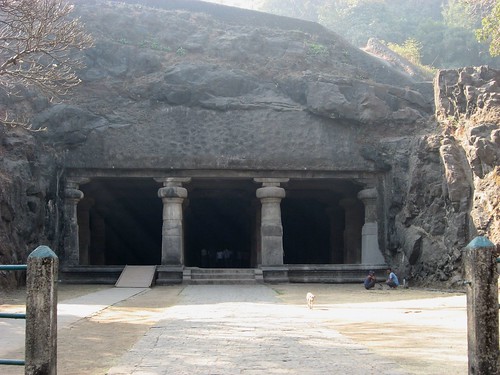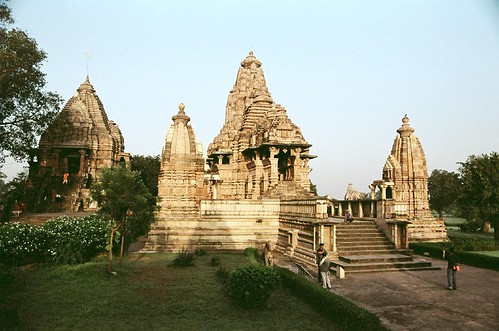The Elephanta Caves are located on Elephanta Island in Mumbai Harbour, about 10 kilometres to the east of Mumbai, India. The island, on an inlet of the Arabian Sea, has a large group of five Hindu caves and a smaller group of two Buddhist caves. The caves are a UNESCO World Heritage Site since 1987, and maintained by the Archaeological Survey of India (ASI).
Saturday, March 13, 2010
Ajanta Caves, World Heritage Site
Photo published under Creative Commons Attribution 2.5 Generic license.
Ajanta Caves, in Maharashtra, India, contain ancient paintings and sculptures of both Buddhist religious art and sculpture.
Cave No. 1 is the first cave, with one of the most elaborate sculptures showing scenes from the life of the Buddha. The cave has a front-court with cells, and a porch, once covered with murals of which many fragments remain now. Each wall of the hall inside is nearly 40 feet (12 m) long and 20 feet (6.1 m) high. There is a shrine on the rear wall to house a seated image of the Buddha. There are four cells on each of the left, rear and the right walls. The walls are covered with paintings, fairly well preserved.
The nearby Cave No. 2 is famous for paintings on its walls, ceilings, and pillars. It has a porch quite different from Cave one. The cave is supported by pillars. The size and ground plan have many things in common with the first cave. The front porch consists of cells.
The caves at Ajanta were abandoned by AD 480 and for the next 1300 years the jungle grew back and the caves were hidden, and unvisited until the spring of 1819 when a British officer in the Madras army entered the steep gorge on the trail of a tiger. Within the tangled undergrowth, he came across the almost hidden entrance to one of the caves. Exploring that first cave, long since inhabited by birds, bats and larger animals, Captain Smith wrote his name in pencil on one of the walls, still faintly visible, it records his name and the date, April 1819.
Tuesday, October 27, 2009
Hijron ka Khanqah
Hijron Ka Khanqah is a monument of the fifteenth century (Lodi period), located in Mehrauli in New Delhi, India, maintained well by the Hijras of Turkman Gate in Old Delhi. The literal meaning of Hijron ka Khanqah is a “Sufi spiritual retreat for eunuchs”.
Hijra is a term generally used in North India for eunuchs. They are a well organized bisexual community and they are considered a religious cult. They dress like women and mostly behave like them. Their presence in special occasions like marriage functions and childbirth are considered auspicious by many people. They are often invited to dance and sing during such occasions.
At Hijron Ka Khanqah there is a large patio where white colored tombs are seen. Of the many tombs there, the main tomb held in reverence is said to be of a Hijra called Miyan Saheb.
Sunday, January 18, 2009
Lakshmana Temple Khajuraho
The photo shows the highly decorated Lakshmana temple along with Matengaswara Temple of simple architecture and ornamentation - picture shot from the Varaha temple. The Matengeswara temple houses a Shiva idol where daily pujas are being performed, unlike in the other temples in the western group of temples in Kahjuraho, built by Chandela kings. Lakshmana temple is believed to be built by the Chandela King of the same name.
The maturity in the sculpture can be seen in various temples as one proceeds from the earlier built temples to the later ones and can be discerned from the form and the variety of the facial and other forms of expressions in the sculptures. It is evident in the most developed, largest and the tallest of the temples, Kandariya Mahadeva Temple on the south western most corner of the temple complex. Location: Madhya Pradesh, India; photo by: Jayashankar, uploaded to Flickr.com on 20 Feb 07, 10.05AM PST.
Saturday, January 17, 2009
Khajuraho 1701093
Welcome to Khajuraho Group of Monuments, A World Heritage!
Khajuraho (Hindi: खजुराहो) is a village located in Chhatarpur District, Madhya Pradesh, India. It is 385 miles (620 KM) southeast of Delhi, the capital city of India.
The Khajuraho group of monuments is listed as a UNESCO World Heritage Site.
One of the most popular tourist destinations in India, Khajuraho has the largest group of medieval Hindu temples and Jain temples which are famous for their sculpture. The name Khajuraho, "Kharjuravahaka" in olden times, is derived from the word "khajur" that means date palm.
Khajuraho 1701092
Here is yet another great shot of western group of monuments of Khajuraho, India
Khajuraho 1701091
Western Group of Monuments, Khajuraho, India
Wednesday, July 30, 2008
Church of St. Augustine at GOA
This is another view of Church of St. Augustine.
One of the major attractions of historical importance in Goa is The Church of St. Augustine built in 1602. According to records, Twelve Augustan Friars pooled their efforts and resources to construct the church on the Holy Hill at Old Goa in September 1572 and the church was completed by 1602. The government under the Portuguese later issued a ban against them. So they abandoned the church and the convent beside it. Both the church and the convent are in ruins now. But the soaring 46-metre high Bell Tower still remains and forms a major segment of the ruins.
The bell in the Bell Tower was removed and installed in the church of Our Lady of Immaculate Conception at Panaji in 1871. It is in working condition even today. The bell tower that remains amid the ruins belongs to one of the four of the St. Augustine Churches that once stood there. Initially there used to be four altars, eight chapels and a convent attached to the church. The Church of St Augustine was considered to be the largest in Goa before it was damaged.
Unfortunately, out of neglect, the facade and half of the tower fell in 1931. In 1938 some more parts fell apart. After being abandoned by the founders, the convent was used for charity work by the institution of the Misericordia for quite sometime. The vault collapsed on 8 September 1842 due to prolonged neglect. The then Government under the Portuguese sold the materials of the remains of the church in 1843, but the few ruins are remaining till today.
Church of St. Augustine, Old Goa
Ruins of Church of St. Augustine, Old Goa, India, was one of the most magnificent churches. It is set atop a tiny hill.
Tuesday, June 24, 2008
Gateway of India, Mumbai
Side view of Gateway of India, Mumbai.









